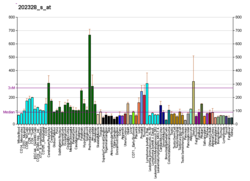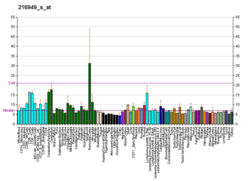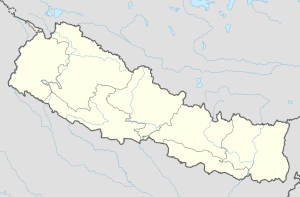폴리시스틴 1
Polycystin 1폴리시스틴 1(종종 PC1로 줄임말)은 PKD1 [5][6]유전자에 의해 인간에게 암호화되는 단백질이다.PKD1의 돌연변이는 대부분의 상염색체 우성 다낭포성 신장 질환과 관련이 있으며, 이는 신장 낭종의 발달과 심각한 신장 기능 [7]장애로 특징지어지는 신장의 심각한 유전 장애이다.
단백질 구조 및 기능

PC1은 주로 1차 섬모뿐만 아니라 꼭대기 막, 아데렌 접합부 및 데스모솜에 [8]발현되는 막 결합 단백질 4303 아미노산이다.그것은 11개의 막 통과 도메인, 큰 세포외 N-말단 도메인, 그리고 짧은 세포질 C-말단 [8][9]도메인을 가지고 있다.이 세포 내 도메인은 PC1이 막 결합 Ca 투과성2+ 이온 채널인 폴리시스틴 2(PC2)와 상호작용하는 코일 코일 도메인을 포함한다.
PC1은 G 단백질 결합 수용체 역할을 [8][10]하는 것으로 제안되었다.C 터미널 도메인은 다양한 방법으로 분할할 수 있습니다.한 가지 경우, 꼬리의 약 35 kDa 부분이 마우스 [11]신장의 유체 흐름 감소에 반응하여 세포핵에 축적되는 것으로 확인되었다.다른 예에서는 전사활성제 및 공동활성제 STAT6 및 p100 또는 표준 Wnt 시그널링 경로의 성분과 억제적인 [12][13]방법으로 상호작용하여 15kDa 단편을 얻을 수 있다.
인간 PKD1-PKD2 복합체의 구조는 극저온전자현미경법으로 해결되었으며, 그 결과 PKD1과 PKD2의 비율이 1:3으로 나타났다.PKD1은 PKD2와 [14]상호작용하는 전압 게이트 이온 채널 폴드로 구성됩니다.
PC1은 신장상피 내의 1차 섬모에 의한 유체흐름의 기계적 감응 및 관절연골의 [15]기계적 변형을 매개한다.
진
PKD1에 대해 서로 다른 isoform을 인코딩하는 스플라이스 변종이 확인되었습니다.이 유전자는 16p [16]염색체의 알려진 중복 영역에 있는 6개의 유사 유전자와 밀접하게 연관되어 있다.
레퍼런스
- ^ a b c GRCh38: 앙상블 릴리즈 89: ENSG00000008710 - 앙상블, 2017년 5월
- ^ a b c GRCm38: 앙상블 릴리즈 89: ENSMUSG000032855 - 앙상블, 2017년 5월
- ^ "Human PubMed Reference:". National Center for Biotechnology Information, U.S. National Library of Medicine.
- ^ "Mouse PubMed Reference:". National Center for Biotechnology Information, U.S. National Library of Medicine.
- ^ Hughes J, Ward CJ, Peral B, Aspinwall R, Clark K, San Millán JL, Gamble V, Harris PC (June 1995). "The polycystic kidney disease 1 (PKD1) gene encodes a novel protein with multiple cell recognition domains". Nature Genetics. 10 (2): 151–60. doi:10.1038/ng0695-151. PMID 7663510. S2CID 20636101.
- ^ "Polycystic kidney disease: the complete structure of the PKD1 gene and its protein. The International Polycystic Kidney Disease Consortium". Cell. 81 (2): 289–98. April 1995. doi:10.1016/0092-8674(95)90339-9. PMID 7736581. S2CID 11114706.
- ^ Torres VE, Harris PC, Pirson Y (April 2007). "Autosomal dominant polycystic kidney disease". Lancet. 369 (9569): 1287–301. doi:10.1016/S0140-6736(07)60601-1. PMID 17434405. S2CID 1700992.
- ^ a b c Zhou J (2009). "Polycystins and primary cilia: primers for cell cycle progression". Annual Review of Physiology. 71: 83–113. doi:10.1146/annurev.physiol.70.113006.100621. PMID 19572811.
- ^ Dalagiorgou G, Basdra EK, Papavassiliou AG (October 2010). "Polycystin-1: function as a mechanosensor". The International Journal of Biochemistry & Cell Biology. 42 (10): 1610–3. doi:10.1016/j.biocel.2010.06.017. PMID 20601082.
- ^ Trudel M, Yao Q, Qian F (January 2016). "The Role of G-Protein-Coupled Receptor Proteolysis Site Cleavage of Polycystin-1 in Renal Physiology and Polycystic Kidney Disease". Cells. 5 (1): 3. doi:10.3390/cells5010003. PMC 4810088. PMID 26805887.
- ^ Chauvet V, Tian X, Husson H, Grimm DH, Wang T, Hiesberger T, Hieseberger T, Igarashi P, Bennett AM, Ibraghimov-Beskrovnaya O, Somlo S, Caplan MJ (November 2004). "Mechanical stimuli induce cleavage and nuclear translocation of the polycystin-1 C terminus". The Journal of Clinical Investigation. 114 (10): 1433–43. doi:10.1172/JCI21753. PMC 1052027. PMID 15545994.
- ^ Low SH, Vasanth S, Larson CH, Mukherjee S, Sharma N, Kinter MT, Kane ME, Obara T, Weimbs T (January 2006). "Polycystin-1, STAT6, and P100 function in a pathway that transduces ciliary mechanosensation and is activated in polycystic kidney disease". Developmental Cell. 10 (1): 57–69. doi:10.1016/j.devcel.2005.12.005. PMID 16399078.
- ^ Lal M, Song X, Pluznick JL, Di Giovanni V, Merrick DM, Rosenblum ND, Chauvet V, Gottardi CJ, Pei Y, Caplan MJ (October 2008). "Polycystin-1 C-terminal tail associates with beta-catenin and inhibits canonical Wnt signaling". Human Molecular Genetics. 17 (20): 3105–17. doi:10.1093/hmg/ddn208. PMC 2722884. PMID 18632682.
- ^ Shi, Yigong; Mei, Changlin; Zhou, Qiang; Wang, Tingliang; Yu, Shengqiang; Lei, Jianlin; Ge, Xiaofei; Hu, Feizhuo; Su, Qiang (2018-09-07). "Structure of the human PKD1-PKD2 complex". Science. 361 (6406): eaat9819. doi:10.1126/science.aat9819. ISSN 0036-8075. PMID 30093605.
- ^ Nauli SM, Alenghat FJ, Luo Y, Williams E, Vassilev P, Li X, Elia AE, Lu W, Brown EM, Quinn SJ, Ingber DE, Zhou J (February 2003). "Polycystins 1 and 2 mediate mechanosensation in the primary cilium of kidney cells". Nature Genetics. 33 (2): 129–37. doi:10.1038/ng1076. PMID 12514735. S2CID 23149223.
- ^ "Entrez Gene: PKD1 polycystic kidney disease 1 (autosomal dominant)".











